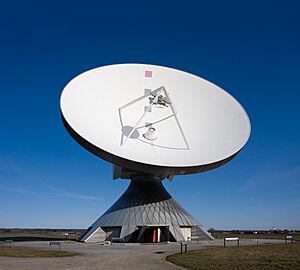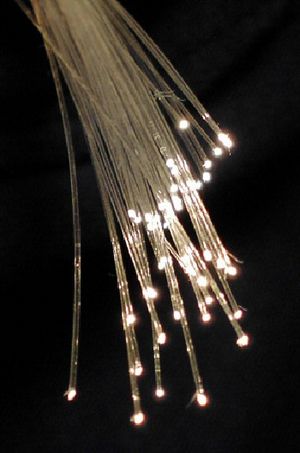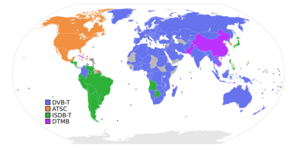Telecommunication facts for kids
Telecommunication (often called telecom) is about sending information over long distances very quickly. It's like talking face-to-face, but without being in the same room! This means old ways like sending letters by mail or using tubes are not considered telecommunication.
Throughout history, people have used many ways to send messages far away. This includes smoke signals, beacons (like lighthouses), flag signals, and even mirrors that flash sunlight. Today, we mostly use electricity to send signals through wires or even through the air. These signals can carry many different conversations or data at the same time.
Before modern times, people used sounds like drumbeats, horns, and whistles to send messages. In the last 100 years, new technologies like the telegraph, telephone, television, and radio all use electricity.
Early telecommunication used metal wires to send signals. This was how telegraphs and telephones worked for many years. In the early 1900s, wireless communication changed everything. People like Guglielmo Marconi made big steps in radio communication. Other important inventors include Samuel Morse (telegraph), Alexander Graham Bell (telephone), and John Logie Baird (television).
Since the 1960s, digital technology has grown a lot. This means we send more than just voices; we send lots of data too. New optical fibre cables can carry huge amounts of information. The Internet has made it possible for people all over the world to connect easily.
Contents
What Does "Telecommunication" Mean?
The word telecommunication comes from two parts. Tele- is a Greek word meaning "distant" or "far off." Communication comes from a Latin word meaning "to share" or "to make common."
The word was first used in its modern way in 1904 by a French engineer named Édouard Estaunié. So, telecommunication is simply "sharing information over a distance."
How Telecommunication Started
In 1932, a group called the International Telecommunication Union (ITU) was formed. They defined telecommunication as sending any kind of signs, signals, writing, pictures, or sounds. This could be by wire, wireless, or other electric or visual ways.
Early Ways to Communicate Far Away
People have used homing pigeons for messages for a very long time. The ancient Persians and Romans used them for military messages. Even Julius Caesar used pigeons when he conquered Gaul. The Greeks also used pigeons to share news of Olympic winners. In the 1800s, a man named Paul Julius Reuter even used pigeons to send stock prices!
In the Middle Ages, people used chains of beacons (fires on hilltops) to send simple signals. For example, they could signal "the enemy is here." This was used when the Spanish Armada attacked England.
In 1792, a French engineer named Claude Chappe built the first fixed visual telegraph system. These were called semaphore towers. They used movable arms to spell out messages. But they needed many towers and skilled people to operate them. They were replaced by electric telegraphs.
Telegraphs and Telephones
On July 25, 1837, the first commercial electrical telegraph was shown in England. It was made by Sir William Fothergill Cooke and Sir Charles Wheatstone.
Samuel Morse also made his own telegraph. His special code, called Morse code, was a big improvement. In 1866, the first transatlantic telegraph cable was finished. This allowed messages to be sent across the Atlantic Ocean for the first time!
The regular telephone was patented by Alexander Graham Bell in 1876. Another inventor, Antonio Meucci, had made a device to send voices electrically in 1849. But it was not very practical. The first telephone services started in 1878 and 1879 in cities like New Haven and London.
Radio and Television
In 1894, Guglielmo Marconi started working on wireless communication using radio waves. By 1901, he showed that radio signals could cross the Atlantic Ocean. This was the start of wireless telegraphy. In 1904, a service began sending news summaries to ships using radio.
World War I helped radio technology grow for military use. After the war, commercial radio broadcasts started in the 1920s. Radio became a very important way to get entertainment and news. World War II again sped up radio development for planes, land communication, and radar.
On March 25, 1925, John Logie Baird showed how to send moving pictures in London. This was the first mechanical television. The British Broadcasting Corporation (BBC) started experimental broadcasts in 1929. Later, televisions used a different technology called the cathode ray tube. Philo Farnsworth showed a promising version of this in 1927. After World War II, television became a major way for people to get entertainment at home.
Computer Networks and the Internet
In 1940, George Stibitz sent math problems from New York to a computer in New Hampshire using a teletype machine. He got the answers back! For a long time, big central computers (mainframes) were used with simple remote terminals.
In the 1960s, scientists started looking into "packet switching." This is a way to send messages in small parts to their destination. On December 5, 1969, a four-computer network was created. This was the beginning of the ARPANET. ARPANET eventually joined with other networks to form the Internet.
How Communication Capacity Grew
The amount of information sent through telecommunication networks has grown hugely. In 1986, it was like two newspaper pages per person per day. By 2007, it was like six entire newspapers per person per day!
This growth means telecommunications are very important for the world's economy. In 2012, the global telecom industry was worth about $4.7 trillion.
How Telecommunication Affects Society
Telecommunication has changed how people connect. At first, telephones were advertised for practical things like business. But by the late 1920s, ads started focusing on emotions. They stressed staying connected with family and friends.
Today, telecommunication is even more important for social life. Social networking sites are very popular. They let you talk to friends, post photos, and share what you're doing. These sites help organize events and even start new friendships.
Before social media, things like text messages (SMS) and phone calls also changed how people interacted. In 2000, a survey found that most young people in the UK used texts to plan social events.
Entertainment, News, and Advertising
| Local TV | 59% |
| National TV | 47% |
| Radio | 44% |
| Local paper | 38% |
| Internet | 23% |
| National paper | 12% |
| Survey permitted multiple answers | |
Telecommunication has made it easier to get music and movies. With television, you can watch films at home. With radio and the Internet, you can listen to music easily.
It has also changed how people get their news. A 2006 survey showed that most Americans got their news from TV or radio, not newspapers.
Telecommunication also has a big effect on advertising. In 2007, over half of all advertising money in the US was spent on media that uses telecommunication.
| Medium | Spending | |
|---|---|---|
| Internet | 7.6% | $11.31 billion |
| Radio | 7.2% | $10.69 billion |
| Cable TV | 12.1% | $18.02 billion |
| Syndicated TV | 2.8% | $4.17 billion |
| Spot TV | 11.3% | $16.82 billion |
| Network TV | 17.1% | $25.42 billion |
| Newspaper | 18.9% | $28.22 billion |
| Magazine | 20.4% | $30.33 billion |
| Outdoor | 2.7% | $4.02 billion |
| Total | 100% | $149 billion |
Rules for Telecommunication
Many countries have laws about telecommunication. These laws follow rules set by the International Telecommunication Union (ITU). The ITU is the main UN agency for information and communication technology.
In 1947, the ITU decided to protect all radio frequencies that were registered. This means that if a frequency is registered, other users should not cause harmful interference.
There have always been debates about how to manage telecommunication. For example, during World War II, countries used international radio broadcasts for propaganda. Today, debates include things like net neutrality (making sure all internet traffic is treated equally) and making sure everyone can get affordable internet.
Modern Communication Methods
Global Sales of Devices
Here are the sales of main consumer telecommunication devices worldwide (in millions of units):
| Equipment / year | 1975 | 1980 | 1985 | 1990 | 1994 | 1996 | 1998 | 2000 | 2002 | 2004 | 2006 | 2008 |
|---|---|---|---|---|---|---|---|---|---|---|---|---|
| Computers | 0 | 1 | 8 | 20 | 40 | 75 | 100 | 135 | 130 | 175 | 230 | 280 |
| Cell phones | N/A | N/A | N/A | N/A | N/A | N/A | 180 | 400 | 420 | 660 | 830 | 1000 |
Telephones Today
When you make a phone call, switches connect you to the person you want to talk to. Your voice turns into an electrical signal. This signal travels through the network and turns back into sound on the other end.
Most home landline phones used to be "analogue." This means your voice directly changed the signal's voltage. Now, phone companies often turn signals into "digital" data for long distances. Digital signals can travel with internet data and sound much clearer.
Mobile phones have changed phone networks a lot. More people now have mobile phones than landlines. In 2005, over 800 million mobile phones were sold! Many mobile phones use digital systems like GSM.
There have been big changes behind the scenes too. Since the late 1980s, optical fibre cables have become very common. These tiny glass fibers can carry huge amounts of data. A single modern optical fiber cable can carry 25 times more calls than older cables. This is because they are small, don't have interference, and can send many signals at once.
A system called Asynchronous Transfer Mode (ATM) helps send data over many modern optical fiber networks. It allows voice data to travel alongside other data. This helps make sure phone calls are clear and not delayed.
Radio and Television Today
In broadcasting, a powerful tower sends out high-frequency radio waves. These waves carry sound or picture information. Your radio or TV tunes into these waves and turns the information back into sound or pictures. The signal can be "analogue" (a continuous wave) or "digital" (information encoded as numbers).
Many countries are switching from analogue to digital broadcasts. Digital broadcasts are better because they prevent problems like "snowy pictures" or "ghosting" on TV. Digital signals are clearer because small errors in the signal don't affect the final picture or sound.
For digital television, there are three main standards: ATSC, DVB, and ISDB. All use MPEG-2 for video. For digital radio, most countries use the Digital Audio Broadcasting standard. The US uses HD Radio, which sends digital information along with regular AM or FM signals.
Even with the switch to digital, many countries still use analogue TV. For analogue TV, there were three main color standards: PAL, NTSC, and SECAM. For analogue radio, signals are usually sent using amplitude modulation (AM) or frequency modulation (FM).
The Internet Today
The Internet is a huge worldwide network of computers. They talk to each other using something called the Internet Protocol (IP). Every computer on the Internet has a unique IP address (like a phone number) that other computers use to send information to it. This allows computers to send and receive messages from each other.
In 2007, the Internet carried 97% of all information flowing through telecommunication networks. About 21.9% of the world's population had Internet access in 2008. North America, Oceania/Australia, and Europe had the highest access rates.
The Internet works because of "protocols." These are rules that tell computers how to communicate. Think of it like different layers working together. This means your web browser can work the same way whether your computer is connected by a cable or Wi-Fi.
For the Internet, the physical way data travels can change many times. For example, across oceans, the Internet often uses the same optical fibre cables as phone networks.
At a certain level, the Internet Protocol (IP) is used for addressing. When you type "Google.com," the Domain Name System turns that into an IP address like 72.14.207.99.
Most Internet communication uses either Transmission Control Protocol (TCP) or User Datagram Protocol (UDP). TCP is used when every message must be received correctly, like for downloading files. UDP is used when it's okay if a few messages are lost, like for live video streaming. Both TCP and UDP use "port numbers" to tell which application the data is for.
Above these, protocols like Secure Sockets Layer (SSL) and Transport Layer Security (TLS) keep your data private and secure. Finally, at the top layer, are the protocols you know, like HTTP (for web browsing), POP3 (for email), and BitTorrent (for file sharing).
VoIP (Voice over Internet Protocol) lets you make phone calls over the Internet. These voice packets can be given priority by network managers. This means your call is less likely to be delayed than other data, like emails. However, on the public Internet, this prioritization doesn't always happen, so call quality can vary.
Local and Wide Area Networks
Local area networks (LANs) are computer networks that cover a small area, like a school or office. They are often simpler and cheaper than larger networks. If they are not connected to the Internet, they can also be more private and secure.
Wide area networks (WANs) are private computer networks that can cover thousands of kilometers. They also offer privacy and security. For example, military and intelligence groups use private LANs and WANs to keep their information secret.
In the 1980s, different communication rules (protocols) were used for LANs. But as the Internet grew, TCP/IP became the main protocol for almost all networks.
For LANs, the most common technologies are Ethernet (wired or wireless) and Token Ring. Ethernet is very popular today. Wired Ethernet often uses twisted copper cables. Faster versions use optical fibers.
See also
 In Spanish: Telecomunicación para niños
In Spanish: Telecomunicación para niños
- Active networking
- Cell site
- Control communications
- Digital Revolution
- Information Age
- Institute of Telecommunications Professionals
- International Teletraffic Congress
- List of telecommunications encryption terms
- Military communication
- Nanonetwork
- New media
- Outline of telecommunication
- Telecommunications engineering
- Telecommunications Industry Association
- Telecoms resilience
- Telemetry
- Underwater acoustic communication
- Wavelength-division multiplexing
- Wired communication






